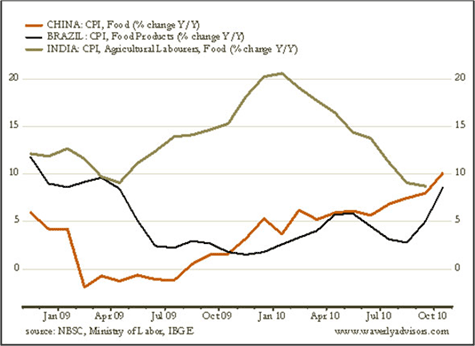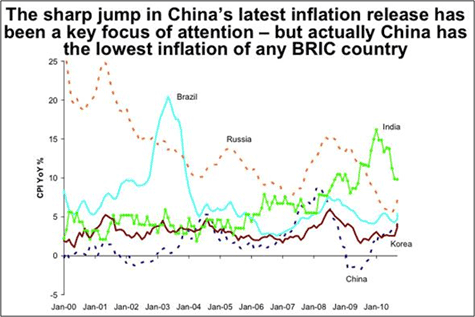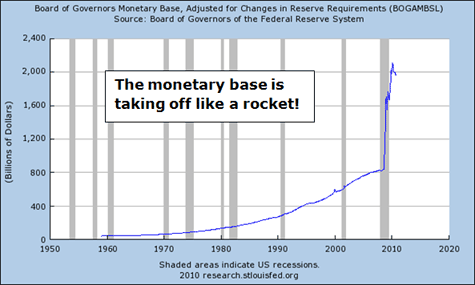The Best Way To Play U.S. Sleeper Inflation
Economics / Inflation Nov 26, 2010 - 10:48 AM GMTBy: Sean_Brodrick
 Like gasoline seeping across a floor, inflation is slowly spreading across the globe, waiting to ignite. When it finally combusts, the move higher in prices could be explosive. Yet many U.S. citizens are going to be caught totally unaware because prices — for now — are generally flat and even falling.
Like gasoline seeping across a floor, inflation is slowly spreading across the globe, waiting to ignite. When it finally combusts, the move higher in prices could be explosive. Yet many U.S. citizens are going to be caught totally unaware because prices — for now — are generally flat and even falling.
This has opportunity written all over it. I’ll get to that in a bit. First, some facts on how the signs of deflation are around us:
Consumer Prices Are Flat. U.S. consumer inflation decelerated in October, according to the Labor Department. The consumer price index increased 0.2% in October. And the core CPI, excluding food and energy costs, was flat for the third straight month. In the past year, the core CPI rate is up 0.6%, the slowest pace on record!
Producer Prices Are Falling. The Producer Price Index rose seasonally adjusted 0.4% in October as energy prices gained, the Labor Department reported. And following 11 consecutive months of gains, core producer prices, which exclude volatile food and energy inputs, fell 0.6% on lower prices for light motor trucks and passenger cars. The core drop was the largest since July of 2006.
Housing Slump Is Getting Worse. Housing starts plunged 11.7% to a seasonally adjusted annual rate of 519,000 from 588,000 in September. That was far worse than the forecast of 598,000. And in October, Clear Capital declared they were seeing the quickest decline in home values since mid-2009, with prices dropping 6% over September and October. Looking ahead, the picture remains grim: Standard & Poor’s predicts that home prices will fall another 7% to 10% through 2011.
So it’s understandable that Americans think prices will remain flat and potentially go lower. The problem is our “deflation” is localized. Across the world, especially in emerging markets, prices are going higher.
Food Prices Soar in China. Prices for food and energy are rising across the globe. But in China, for example, the price of a basket of 18 key vegetables rose by 62.4% year-over-year in the first 10 days of November, after jumping 10.1% in October. The problem is so bad, the government has vowed to take steps to keep a lid on prices.
The State Council, China’s cabinet of ministers, said last week that it would stabilize prices for grain, oil, sugar and cotton. The last time it did this (the end of 2007), it slapped price controls on foods it wanted to control.
However, unlike past bouts of food inflation in China, there have been no major droughts or diseases to drive up prices this year. China is blaming money brought by foreigners investing in Chinese real estate, and is cracking down on that, too. But it’s more likely that as the Chinese become more prosperous, they’re eating better.
And while Beijing bureaucrats can restrict the rise in prices of food grown at home, it can’t restrict the price of food it imports from the rest of the world. China was once self-sufficient in grains, including wheat, soybeans and corn, but now has to import more and more.
Inflation Beyond China. Food inflation isn’t a problem only in China. Three of the biggest emerging markets, Brazil, India and China — 40% of the world’s population — are experiencing serious food inflation.

And it’s not just food. In fact, Morgan Stanley recently published a chart showing that, in measures of broad consumer prices, China has the lowest inflation of any of the BRIC (Brazil-Russia-India-China) countries …

Source: Morgan Stanley
In fact, across the emerging markets, inflation is running at around 5.5% year over year.
So why are prices rising in these emerging markets and not in the United States? It’s a combination of factors — hot money, rising wages, and scarcity of commodities which has led to very real price hikes. Costs of raw materials are rising. In fact, year-on-year inflation in commodity prices is running at 64%.
But the U.S. consumer is weak. So our suppliers in China feel they can’t pass higher prices along. That’s worked for a while — it won’t work forever.
Now for the Real Gasoline on the Fire
The Fed is purchasing trillions of dollars of Federal debt, and creating boatloads of money (even if in only an electronic sense) to do so. This has sent the monetary base skyrocketing, from just $800 billion to more than $2 trillion in a matter of months. Take a look at this next chart and you’ll see what I mean:

The only reason this hasn’t led to inflation yet is that banks aren’t lending the money out … yet. But it’s likely that banks will start to lend more money as the economy slowly improves.
That excess cash could cause inflation to ignite — and we could see prices in this country rise very quickly.
How to Play “Sleeper” Inflation
For now, U.S. inflation is hitting the snooze button. Where do you want to be invested when it wakes up? I think precious metals is an obvious answer. And the recent pullback is giving you a big opportunity.
Here are some recent gold facts from the World Gold Council …
- Total gold demand in the third quarter of 2010 was 922 tonnes, an increase of 12% from the same period a year ago. In U.S. dollar value terms, demand grew 43% to $36.4 billion over the same period.
- Demand for gold jewelry increased by 8% from third quarter of last year, with four of the best performing markets — India, China, Russia and Turkey — accounting for 63% of global demand.
- The total value of net retail investments during the quarter was a record $9.6 billion, representing a 60% increase from the year-earlier quarter. The largest contribution to total demand growth came from bar hoarding, which increased 44% from the previous year.
- Gold jewelry demand is likely to exceed that of 2009 due to an anticipated recovery in India, the most significant gold jewelry market, and continuing strength in China.
Demand for gold obviously remains strong, and pullbacks will bring physical buyers out of the woodwork. Gold is a historical inflation hedge, and I think it’s cheap compared to where it will be a year from now.
Yours for trading profits,
Sean
This investment news is brought to you by Uncommon Wisdom. Uncommon Wisdom is a free daily investment newsletter from Weiss Research analysts offering the latest investing news and financial insights for the stock market, precious metals, natural resources, Asian and South American markets. From time to time, the authors of Uncommon Wisdom also cover other topics they feel can contribute to making you healthy, wealthy and wise. To view archives or subscribe, visit http://www.uncommonwisdomdaily.com.
© 2005-2022 http://www.MarketOracle.co.uk - The Market Oracle is a FREE Daily Financial Markets Analysis & Forecasting online publication.



